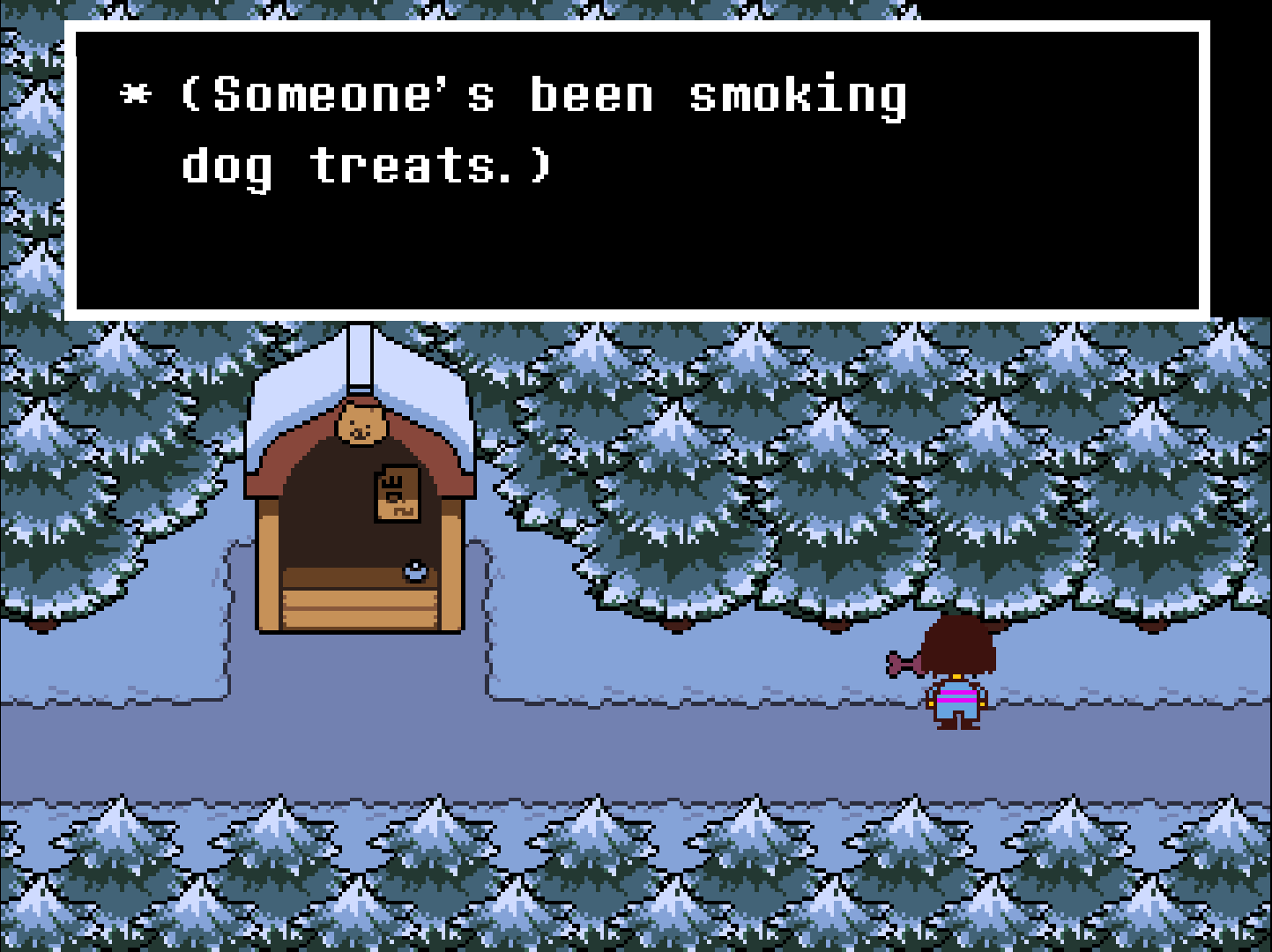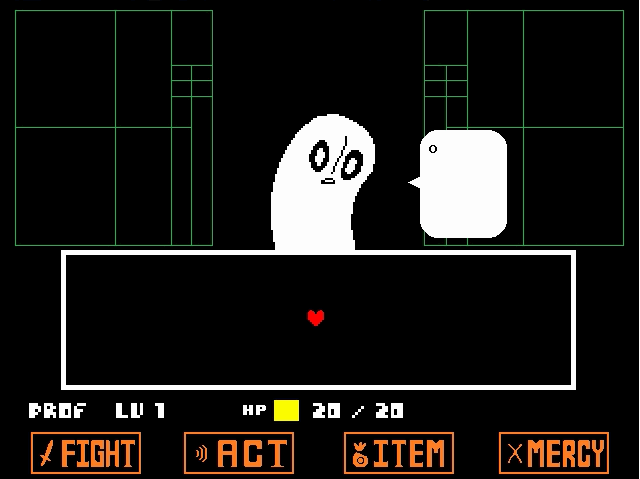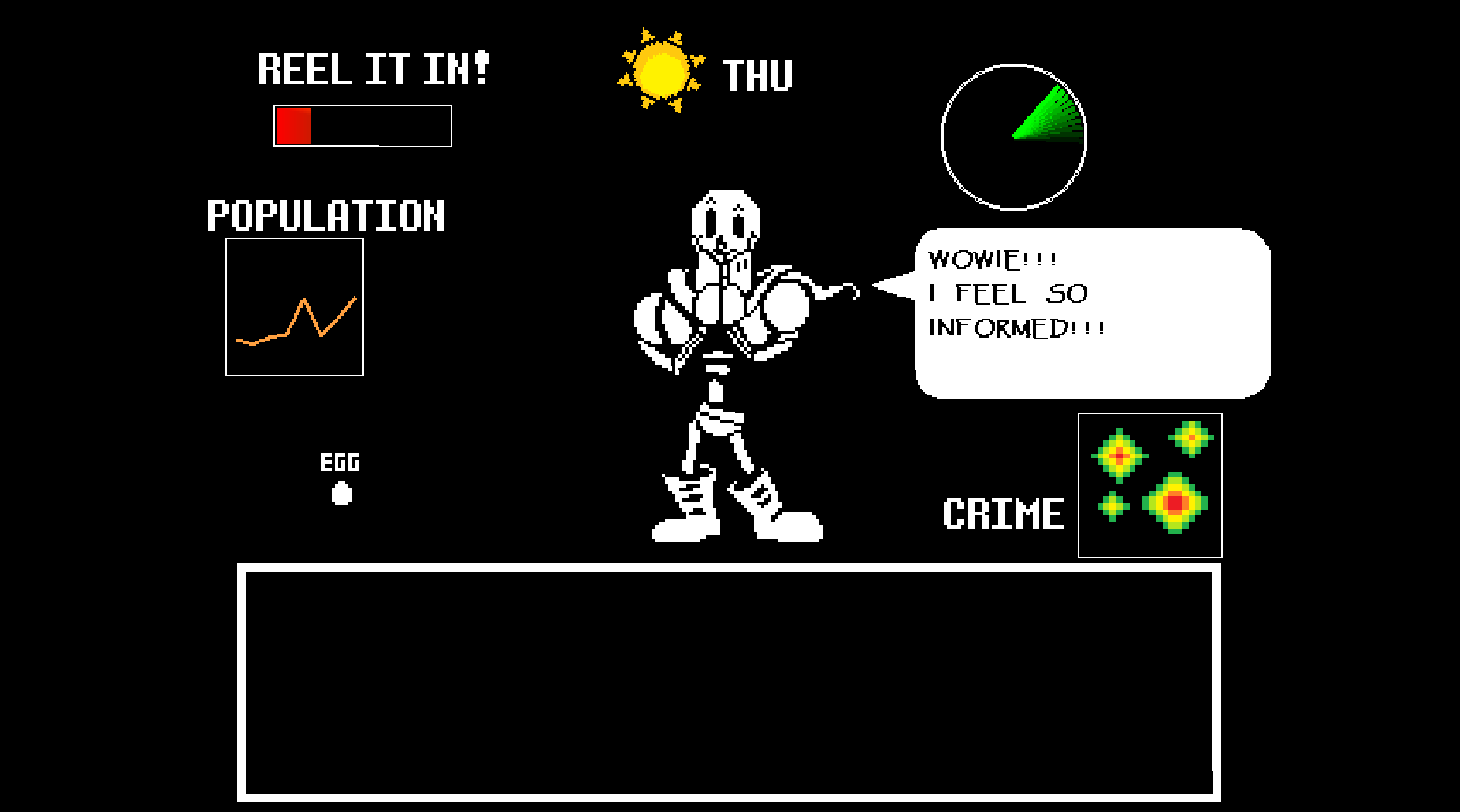Undertale is a quirky 2D RPG developed in Game Maker by a guy who did some music for the webcomic/internet thing Homestuck. That last sentence is overloaded with stuff I like, so obviously I had to check this game out as soon as possible. Knowing me, as soon as possible can often translate into six months to a year after release once it’s already been talked to death by other, better people, but I digress.
There are a lot of good reasons to get this game, and only a very few questionable reasons not to. So, once more, this is going to be a positive review. As is customary with my longer reviews, it’s probably going to end up more of a discussion of the game than a buyer’s guide per se, so take warning: here be spoilers – light and vague at first, but getting heavier as the article progresses.
If you’re the kind of person who likes to go into things with absolutely no knowledge of anything about them, then why are you even reading a review? Go play the game already! If you’re the kind of person who can tolerate a few vague, early-game spoilers, keep reading.
# Presentation

Some incidental flavour text which you will now be forced to read for the nth (n>1) time in the actual game.
So let’s start with the non-spoilery, surface layer stuff. Individually, Undertale’s sprites and tiles range in appearance from unremarkable to downright ugly. But everything works decently well together, and the overwhelming charm of the game still manages to come through. As can be seen by looking at the screenshots I’ve collected for this review, Undertale is also remarkably visually inventive at times, especially in the late-game battle scenes.
The music is a different story. The game’s developer is foremost a composer, mostly known for his work on Homestuck, and as a result Undertale’s soundtrack more than make up for any deficiencies in its graphical fidelity. This is one of those games where you’ll find yourself searching for a particular boss fight song and listening to it on loop even after you’ve finished the game.
Sound design is nothing to write home about: the game has sounds for everything you would expect to make a sound, and those sounds sound like they should. There is no voice acting, but each major character gets their own text-scrolling sound.
# Gameplay
If you’ve seen Undertale’s Steam store page, website, or any other articles or reviews of it – even if you only read one sentence in one of those sources – you’ll already know that the game has a heavy focus on pacifism: it advertises itself as a game where no-one has to die or be destroyed for the player to win. This immediately brings to mind Iji, another Game Maker-made 2D RPG1 with a moral about pacifism that also just happens to be one of my favourite games. Undertale is very much its own thing, but I’ll be using a number of comparisons to Iji to discuss it.
Undertale is in many ways the next logical step after games like Iji and Spec Ops: The Line: whereas those games presented themselves upfront as uncomplicated, traditional shooters, only getting into moral complexities past the initial stages of the game, Undertale wears its pacifism on its sleeve. From before you even start the game, you are explicitly told in multiple ways that you don’t have to kill any enemies to win, that you shouldn’t fight and slaughter everything like in other games. But, critically, you have the option to do just that.
In Iji, pacifist playing meant skipping out a lot of core gameplay. Sure, there were some interesting tricks you had to learn here and there to get through the game without killing, but largely pacifism meant running around, dodging enemies and not participating in the meat of gunfights or collecting different weapons, using the crafting system to make new ones or maxing out any of your weapon skills. The game clearly wanted you to play as a pacifist, but doing so deprived you of much of the game’s lovingly crafted core systems.
In contrast, pacifist playing in Undertale means getting the more interesting experience. Gameplay is split into solving puzzles in the overworld and encountering enemies in that JRPG mainstay, the turn-based combat interface. While varied and occasionally clever, the overworld puzzles serve more of a story role, with characters complaining about them and occasionally solving them for you. The real meat of the gameplay is (ironically) in the combat interface. This interface gives you four types of options, shown below.

FIGHT leads to a fairly boring screen where you have to time a keypress carefully to do more or less damage. ACT allows you to a number of different things depending on the enemy encountered: you can TALK TO some, COMPLIMENT others, PET and PLAY FETCH with a few dog-themed ones, and UNHUG a particularly reserved species of mold. ITEM lets you use something in your inventory, usually a healing item, but often something you can use on or give to an enemy. Finally, MERCY allows you to either FLEE a fight or SPARE your enemy, should they be unwilling to fight.
In pacifist playing, the way to deal with these fights is to find the right combination and sequence of ACT actions (and sometimes ITEMs) to make the enemy agreeable to being SPAREd. This can be as simple as COMPLIMENT or a fairly involved sequence of actions. Sometimes you need a specific item.
What makes this challenging is that, while you may not want to fight others, they’ll almost always want to fight you, at least initially. While figuring out how to calm them down so they can be spared during your turns, you need to dodge their attacks in a bullet-hell-style minigame during their turns. The sheer variety and inventiveness of the various styles of enemy attack in these minigames is one of Undertale’s great strengths. It’s incredible how much exciting and different gameplay has been squeezed out of the simple concept of dodging stuff in a little box.

Static images don’t do these sequences justice.2
Adding a further wrinkle to this challenge of dodging attacks is that to get more HP, you need to level up, and the only way to do that is to earn EXP. And EXP in Undertale denotes Execution Points, not Experience Points. If you go through the entire game without killing, you also go through the entire game on the starting level, with the starting 20 HP. In the final boss fights, this means a lot of dying and starting over, if, like me, you have below-average reflexes.
The game talks a lot about “determination”, and that’s what you need to play it without killing anyone. But more than that, and where the game veers occasionally into questionable design territory, is that you have to solve some fairly obtuse puzzles and take some very counterintuitive actions. To quote Kill Screen’s Jake Muncy:
…these conflicts require the player to take advantage of hidden mechanics, repeat actions without knowing whether or not they’ll succeed, and subsist under a barrage of enemy attacks.
[…]
The player’s choice, then, to fight or not to fight, is not one necessarily related to roleplaying or ethical considerations. It’s also a mechanical consideration. A failure to deliver mercy might simply be a failure to solve a puzzle, or figure out a way to survive with inadequate resources.
While I agree with this general point about some sections of the game – notably, there’s a section right near the end where the only way to proceed is to use the FIGHT screen, even if you’ve gone through the entire game up to that point without seeing it – I don’t entirely agree that it applies to the section he speaks about at the beginning of that article, which is actually one of my favourite parts of the game.
Early-game spoilers below the image and until the end of the section.

Usually I take screenshots for these reviews after I’ve finished the game, but this one had so many striking moments I’ve actually got a surplus.
One of the first characters you meet in Undertale is Toriel, a sweet, motherly goat-headed woman who guides you through the game’s first couple of puzzles. She’s quite protective of the protagonist, a small child, and harbours some notions about looking after them as some sort of mother/teacher figure,3 to the point where she challenges you to a fight if you attempt to proceed in the game past a certain point.
You want to leave so badly? Hmph. You are just like the others.
There is only one solution to this. Prove yourself… Prove to me you are strong enough to survive.
Toriel, pre-battle
The first time I got to this point, I tried to SPARE Toriel a few times. When that seemed not to be having any effect, I figured that maybe the game wanted me to fight her down to low HP, and would then let me spare her, having sufficiently “proven myself”.
But the closer Toriel gets to 0 HP, the more damage your attacks inflict. My strategy ended with me overshooting the mark and killing her. This, of course, was horrifying and made me immediately think I must be missing something and would need to try another strategy. I quit without saving, did a bit of googling and sure enough, the actual solution was, somewhat counter-intuitively, just to spare Toriel ten or more times, despite getting very little feedback from the game that this was the intended solution.
So I reloaded the game and repeated the fight, this time sparing Toriel until she gave up and allowed me to continue on with the game. Greatly relieved, I left the first area, only to encounter a character who knew exactly what I’d done – killed Toriel and then reloaded – and berated me for it. Not something I was expecting, but a brilliant element acknowledging that this particular puzzle was essentially a meta one – you were expected to accidentally kill Toriel and then immediately reload and try something else.4
There are other enemy encounters which are less formally interesting and may tempt you to refer to the wiki to figure them out. I won’t shame you for it, as I did this a few times myself.
# Story
As one might expect, Undertale owes a lot of its atmosphere and general narrative and humour sensibilities to Homestuck, and to Earthbound, their mutual inspiration. Even so, it’s very much its own, distinct thing.
As the opening cinematic tells it, once long ago, humans and monsters lived together on Earth. Then there was a war and all the monsters were driven underground and magically trapped there. You, a human child, fall into the underground where the monsters live and spend the game trying to get back to the surface.
In yet another similarity to Iji, Undertale has one of those modern settings where humans are the oppressors of a fantasy race traditionally seen as the very opposite of oppressed masses – here, “monsters”. The game’s denizens are mostly terrified of humans, though a couple of them are really into the idea of killing a couple. As is revealed fairly early, a number of human souls are required to break the magical barrier keeping the monsters trapped underground, making your death potentially very beneficial to monsterkind.
In Iji, you start the game as one of the only two humans left alive in a large research building that’s been overrun with hostile aliens who will attack you on sight. In Undertale, you have to traverse a world full of hostile monsters who would greatly benefit from your death. In both, you can choose to use these facts as a reason to kill everyone. But choose that path in Iji, and you can restart the game after a particularly depressing credits sequence and do everything peacefully. Undertale remembers.
So there are two stories in Undertale: in one, you refuse to fight and kill, weather the assaults of many assailants, and ultimately befriend them. It’s a slightly sappy but sincere story about a bunch of quirky characters and the power of friendship.

The friendship HUD, full of information essential to hanging with your pals.
In the other, you kill everyone. I don’t know the details of this one firsthand, but anyone choosing to go for this story, as a 100% completionist thing or maybe just to see what happens, will have their transgressions permanently recorded, and any subsequent peaceful playthroughs will be tainted with small reminders. This seems like a natural outgrowth of Undertale’s insistence that you take its moral code seriously and treat its characters like real people who you shouldn’t want to kill, even to see what happens.
As far as I can tell, this alternate path through the game isn’t really worth it. You could argue that its very existence acts as a reward for players choosing to commit genocide rather than play peacefully, but I think it mainly exists to actually give you the choice of killing everyone, so that the choice not to means more than just proceeding in the game like you’re playing a Call of Duty campaign. Despite apparently having whacks of extra boss fights and content, I don’t really think it was intended to be played, and I’m not about to spend hours of my life killing hundreds of endearing characters.
So my advice for playing Undertale is to do what it says on the box and don’t kill anyone.
# Conclusion
Undertale comes with a lot to recommend it. It’s artsy but with lots of real gameplay and content, it’s quirky but with warmth and heart, it’s graphically basic but with many striking scenes, and it has a top-tier soundtrack. Reasons not to play it are if you completely disagree with my taste in games, have even shoddier reflexes than mine and/or dislike 8-bit chiptune music for some reason. I can’t really think of any others.
-
Undertale’s TVTropes page is quite insistent on giving you lots of similar games to compare it to. ↩︎
-
This is the first time I’ve ever put a GIF in an article. I don’t feel any different just yet, but I’m worried I’ll wake up tomorrow with the urge to rewrite this review in numbered headings. ↩︎
-
The protagonist is supposed to be of ambiguous gender, and is always referred to in-game by they/them pronouns. Personally I think she’s a girl. ↩︎
-
This part of the game immediately reminded me of Jesse Venbrux’s Execution, a very small, brief, experimental piece that subverts the same save-scumming type of logic, but in a much more brutal way. It’s really good to see experimental things like this winding up as supporting elements of fully fledged games. ↩︎
 David Yates.
David Yates.